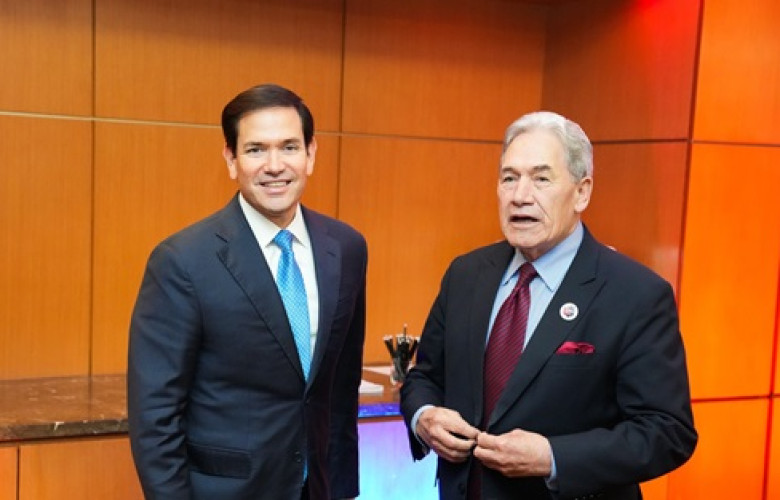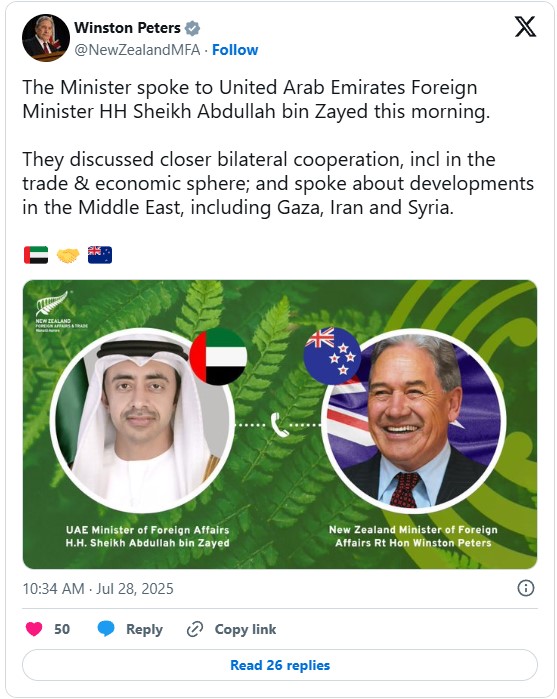US tariff decision gives New Zealand plenty to think about
Geoffrey Miller, International Analyst, Democracy Project
2025-08-04
NEW ZEALAND
GEOPOLITICS
This article was originally published by The Democracy Project. It is republished under a Creative Commons license

That was the message from New Zealand’s trade and finance ministers in their initial response to Donald Trump’s new, higher ‘reciprocal tariff’.
New Zealand exporters of most goods to the United States now face a 15 per cent import duty, a significant increase on the 10 per cent ‘baseline’ figure in place since April.
A stony-faced Nicola Willis, the finance minister, called Trump’s move a ‘disappointing development’, arguing that New Zealand had suffered from the application of a ‘very blunt formula which does not take account of the low tariffs we impose on US products’.
The argument from Willis – echoed by trade minister Todd McClay – was that the tariff resulted from New Zealand’s trade surplus with the United States. Essentially, New Zealand had been a victim of its own success.
Both Willis and McClay pledged to protest the decision to their US counterparts. In a statement, McClay said he was seeking an ‘urgent call’ with the US Trade Representative, adding that the New Zealand Government would ‘advocate strongly for a resolution that supports our exporters’.
Willis played down the extent of the trade surplus, saying that New Zealand exported only ‘slightly more’ to the US than it imported in return. This is true for merchandise trade. New Zealand had a surplus of around ten per cent, or roughly $NZ900 million, on $NZ9.3 billion of goods exports for the year ending in March 2025.
However, when services are included, New Zealand enjoys a much larger trade surplus of over $NZ4 billion on a total of nearly $NZ17 billion of exports. The distinctions – tariffs apply only to goods, not services – are unlikely to matter overly to Donald Trump.
New Zealand’s exports to the United States have prospered in recent years, boosted particularly by strong demand for red meat exports. The US leapfrogged Australia to become New Zealand’s second-biggest export market in 2024.
In Donald Trump’s geopolitical and dealmaking terms, New Zealand probably got off lightly with the 15 per cent tariff figure. The duty puts it level-pegging with Japan and South Korea, both longstanding US allies, as well as the European Union. In Asia, most members of ASEAN – with which New Zealand maintains close trade ties – now face tariffs of 19 or 20 per cent, although Laos and Myanmar were both hit by 40 per cent import duties.
However, Willis and McClay probably realised that claiming New Zealand had received the best deal it could have reasonably expected from Washington would not go down well with voters.
Australia, which succeeded in convincing the United States to keep it at the 10 per cent baseline figure, would have been firmly on their minds – and on the minds of New Zealanders who compare their economic fortunes most closely with their richer neighbour.
The timing of the tariff news was unfortunate for Luxon, McClay and Willis. The trio are all from the National Party, which was holding its annual conference in Christchurch over the weekend that provided an opportunity to trumpet the party’s economic management record.
Now more than half-way through the parliamentary term – elections must be held by December 2026 – Luxon is keen to demonstrate progress on economic growth and cost-of-living measures.
In her comments on Friday, the finance minister tried to provide some context and comfort, noting that New Zealand’s exports had surged in value by 11.4 per cent in the year to June. The increase has been driven by high food commodity prices. The success helped to generate GDP growth of 0.8 per cent in the first quarter of 2025, a much stronger performance than economists had dared to hope for.
The irony is that the export-led recovery has also led to higher prices for food at home, particularly for household staples such as butter. Annual inflation edged up to 2.7 per cent in June, the highest figure in a year. Inflation and the cost of living remained the top priority for 55 per cent of voters in a June survey by polling company Ipsos, an increase of five percentage points from the previous poll in February 2025.
On the wider geopolitical front, the US tariff decision will raise questions over New Zealand’s strategy for handling Donald Trump’s United States. Wellington has sought to forge closer ties with Washington in recent years. The approach has been accelerated by Winston Peters, the foreign minister who represents the New Zealand First party in the coalition government.
In April, Peters advocated softly-softly tactics when dealing with Washington, publicly rebuking his own Prime Minister and telling him to ‘call me next time’ after Christopher Luxon conducted a series of calls with other leaders and advocated a solidarity-based approach by countries impacted by the tariffs. A week after Trump’s ‘Liberation Day’ bombshell, Luxon gave a prepared speech to a business audience that suggested ‘one possibility is that members of the CPTPP and the European Union work together to champion rules-based trade’.
The CPTPP, or the Comprehensive and Progressive Agreement for Trans-Pacific Partnership, is a free trade agreement co-founded by New Zealand that now involves 12 countries from around the Pacific Rim and the United Kingdom. The United States very nearly became a member, but Donald Trump withdrew the US from the deal at the start of his first term in January 2017.
Behind the scenes, Peters met Secretary of State Marco Rubio in a low-profile encounter at an ASEAN meeting in Malaysia in July, which built on an earlier discussion between the pair in Washington in March. For his part, McClay reported on Friday that he had held two in-person meetings and one virtual discussion with his counterpart since April to try and convince the United States to tread lightly when imposing tariffs on New Zealand.
New Zealand has also made tactical decisions on other matters involving the United States to try to avoid giving Washington any cause for retaliation.
Last week, for example, New Zealand police and defence ministers enthusiastically welcomed a visit by US Federal Bureau of Investigation (FBI) Director Kash Patel to Wellington to open a new ‘standalone’ office at the US Embassy.
While the FBI Director’s New Zealand counterparts highlighted benefits for cooperation in combating international criminal groups and drug smuggling, Patel released a video that cited ‘countering the CCP [Chinese Communist Party] in the Indopacom theatre’ as a primary motivation for the new office.
The line prompted an angry response from the Chinese Embassy in Wellington, stating ‘we strongly oppose any attempt to make groundless assertions or vilification against China’. China is New Zealand’s biggest market, buying over $NZ21.5 billion of goods and services (more than 20 per cent of New Zealand’s total exports) in the year to March 2025.
Meanwhile, New Zealand has stopped short of joining France, Canada, Malta and the United Kingdom in pledging to recognise a Palestinian state at the UN General Assembly in September.
This does not mean Winston Peters is not sympathetic to the idea: to the contrary, he has said ‘it’s not a matter of if, but when’. Indeed, the foreign minister has clearly been genuinely appalled by the war in Gaza. Peters has been remarkably outspoken on the issue, despite his affinity with the United States and Israel.
For instance, in a ministerial statement to the New Zealand Parliament on 22 July, Peters said: ‘The international community is united in its revulsion to what is happening in Gaza. This horror must end’. The words followed a joint statement by Peters and 27 other foreign ministers released the previous day that said the ‘suffering of civilians in Gaza has reached new depths’ and reiterated calls for a ceasefire.
And Peters subsequently signed a further joint statement with 14 other foreign ministers on 29 July that included a line noting the ‘positive consideration of our countries to recognize the State of Palestine’. Last week, Peters also held a virtual meeting with the influential United Arab Emirates (UAE) foreign minister, Sheikh Abdullah bin Zayed Al Nahyan, in which ‘developments in the Middle East, including Gaza, Iran and Syria’ featured as a topic of discussion.
New Zealand is clearly inching closer to recognising a Palestinian state – a decision that will be deeply unpopular with both Israel and the United States.
But the US tariff decision has been made.
New Zealand may no longer attempt to pull its punches.
Geoffrey Miller is the Democracy Project’s geopolitical analyst and writes on current New Zealand foreign policy and related geopolitical issues. He has lived in Germany and the Middle East and is a learner of Arabic and Russian. He recently submitted his PhD at the University of Otago on New Zealand’s relations with the Gulf states.
This article can be republished under a Creative Commons CC BY-ND 4.0 license. View the original article at the Democracy Project here.
Photo: U.S. Department of State, Public domain, via Wikimedia Commons
Membership
NZIIA membership is open to anyone interested in understanding the importance of global affairs to the political and economic well-being of New Zealand.
